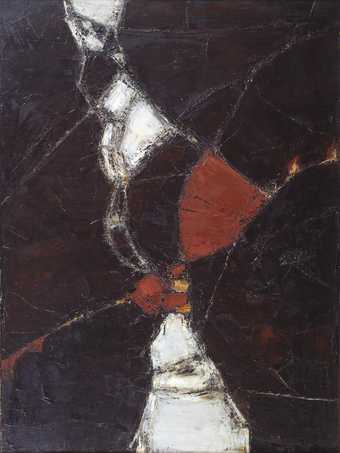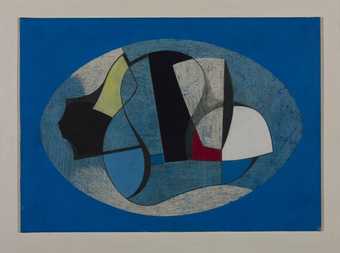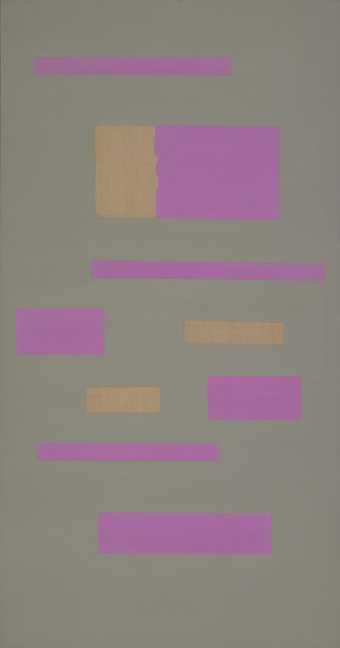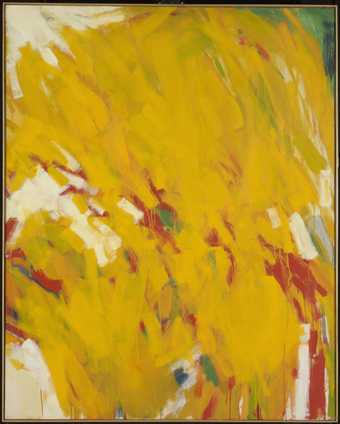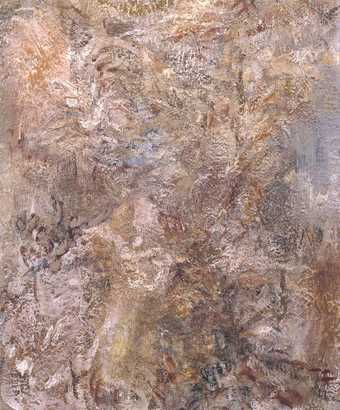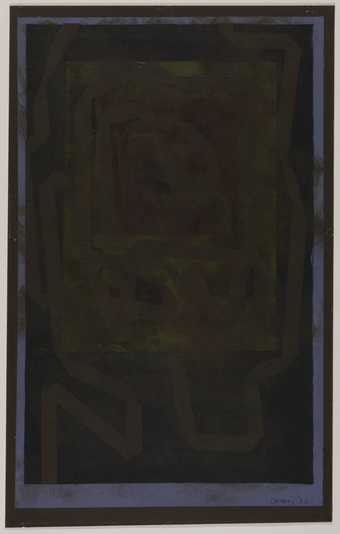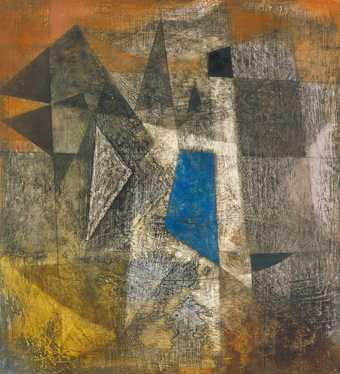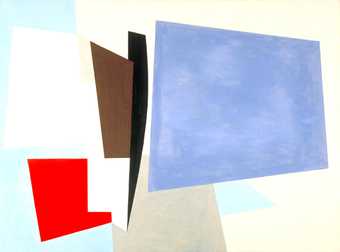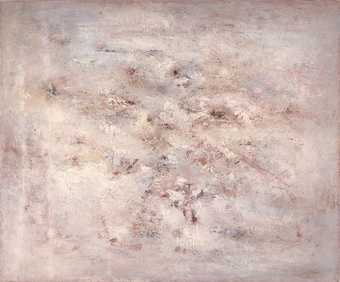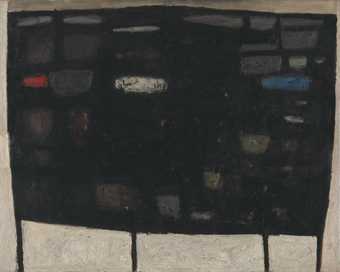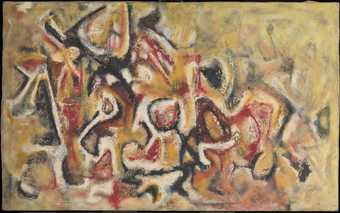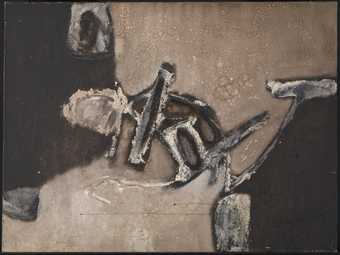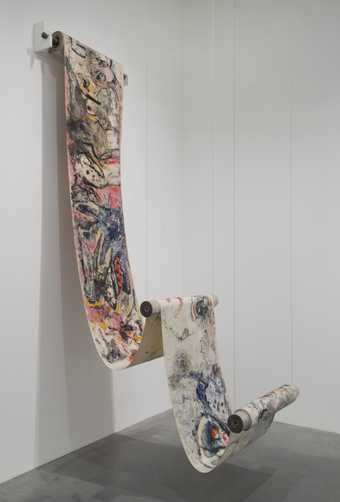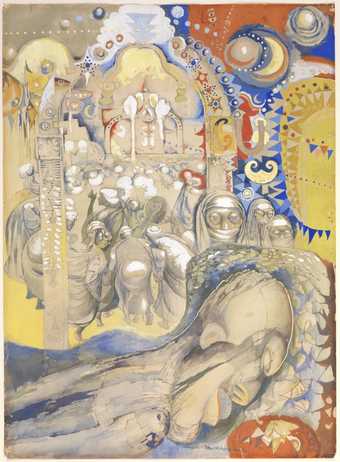
In Tate Britain
- Artist
- Denis Williams 1923–1998
- Medium
- Oil paint, ink and graphite on board
- Dimensions
- Support: 789 × 786 mm
overall: 855 × 855 mm - Collection
- Tate
- Acquisition
- Purchased 2020
- Reference
- T15543
Summary
Painting in Six Related Rhythms 1955 is a geometric abstract painting on wood, the square panel being displayed in a diamond format. The basis of the painting is a marked-out grid of one-inch squares that are bisected and segmented to create a lattice representing an irregular crystalline form. A vertical tapering shaft of white divides the painting centrally, running vertically from the red square that marks the bottom corner of the painting and cutting through the grey square that marks the top corner. Either side of this shaft is a succession of grey similar elongated shapes that frame it but also ambiguously define a point of view as both looking-in and looking-out. Filling the rest of the panel, the latticework provides a structure that is syncopated by irregular areas of blues, whites, greys, ochres and reds. Evelyn A. Williams, the artist’s daughter, has observed that:
the painting has not been developed ‘on a wholly systematic basis of mathematical proportion. Whilst a geometric control is supplied by the grid, the painting is spontaneous in its balance of relationships and in its use of colour … In places, the underlying grid comes to the surface above the colours; in other areas it disappears or is masked; sometimes the grid is scratched back through the paint … He uses a wide range of techniques, creating a richness and subtlety that counters the severe geometry. Scumbling, sgraffito, fine brush hatching and overlays lead to soft textural effects.
(Williams 2012, p.53.)
The painting was made in London and is the last of a series that Williams designated as Plane Compositions, some of which were exhibited in his exhibition at Gimpel Fils, London in 1954 (shared with Roger Hilton [1911–1975]) and at the New Burlington Galleries, London in the Young Artists’ Exhibition of 1955. A related painting also entitled Painting in Six Related Rhythms of 1954 won a prize at the latter exhibition and was acquired by the Beaverbrook Foundation (Beaverbrook Art Gallery, Fredericton, New Brunswick). The paintings exhibited at Gimpel Fils had titles such as Painting in Five Related Rhythms and Painting in Four Related Rhythms, both 1954, or Vertical Composition with Arc of a Circle 1953, and were exhibited with a group of works designated Reliefs and another group designated Constructions. Although none of these works appears to have survived, they attest to the artist’s closeness to the constructionist group of artists working in London at this time.
Prior to this, in his previous exhibition at Gimpel Fils in 1950 (shared with the outsider artist ‘Scottie’ Wilson [1889–1972]), Williams had shown paintings whose imagery reflected the landscape and experience of his native British Guiana – as typified by his 1949 Plantation series of oil paintings and the cycle of paintings Four Dimensions of Anguish 1950, in particular Human World 1950 (National Gallery of Art, Georgetown, Guyana). In contrast, his 1954 exhibition reflected the allegiances he had formed with the constructionists and related abstract painters while he was teaching at the Central School in London through the early 1950s – alongside artists such as Victor Pasmore and William Turnbull, John Ernest, Anthony Hill and Roger Hilton. Many of these artists gathered and exhibited in Fitzroy Street at the studio of the painter Adrian Heath (1920–1992) and, in 1953, Williams exhibited two of his column Plane Compositions at the third such exhibition in May 1953, alongside Hill, Hilton and Pasmore, as well as Robert Adams, Terence Conran, Kenneth Martin, Ben Nicholson, Eduardo Paolozzi and William Scott. His connection with these artists and the constructionist tendency was short-lived, however, culminating in his involvement with Group 5’s presentation within the exhibition This is Tomorrow (Whitechapel Art Gallery, London, 1956) – for which Ernest, Hill and Williams positioned their own work alongside replicas they had also made of work by Soviet constructivists Aleksander Rodchenko (1891–1956) and Kazimir Malevich (1879–1935), as a way of expressing a direct linkage between their work and pioneering abstract work from the second decade of the century. By this time, however, Williams felt typecast within the London avant-garde, and the following year he left Britain having accepted a teaching post in the Sudan.
Painting in Six Related Rhythms signals both an integration within the mainstream of British modernism and a clear break with the artist’s earlier paintings that directly evoke figurative motifs. Evelyn A. Williams, however, has observed that, although ‘the influence of non-European sources within the iconography of twentieth-century modernism is readily appreciated in the figurative legacy, as a vital source these influences are less immediately apparent in abstract art’ (Williams 2011, p.166). She then describes how the artist Wyndham Lewis (1882–1957) had compared the sustained use of yellow in many of Williams’s paintings to the effect of a tom-tom; that the Guyanese writer Wilson Harris referenced the timbre and rhythms of the West Indian steel bands; and that Williams himself recalled this particular painting as being described as ‘Mau Mau Mondrian’ (Williams 2011, pp.166–7). In this way the ‘rhythms’ of the painting can be defined formally through the interplay of the lattice composition and the restricted palette that evokes the action of a crystal. The rhythms can also be understood through Williams’s own understanding of books then current and inspirational for those artists in his circle, such as d’Arcy Wentworth Thompson’s On Growth and Form (2nd edition 1942), Paul Klee’s On Modern Art (1948) and Charles Biederman’s Letters on the New Art (1951) that, taken together, suggested a rational formal language that translated structures in nature into abstract composition. However, Evelyn A. Williams has further observed that ‘it is interesting to consider to what extent non-European “survival rhythms” are embedded in the subconscious personal iconography of Williams’ abstract work … a resounding repetition of motifs around the central composition; a roughly vertical symmetry, a primal punctuation of line; a balancing of massive three-dimensional form; parallel hatching; interlacing curves and the interlocking of planes.’ (Williams 2012, p.57.)
Further reading
Charlotte and Evelyn A. Williams (eds.), Denis Williams: A Life in Works. New and Collected Essays, Amsterdam 2010.
Evelyn A. Williams, ‘Denis Williams in London: 1946–1957’, Third Text, vol.25, no.2, April 2011, pp.157–68, reproduced p.166 (incorrectly identified as Painting in Six Related Rhythms 1954).
Evelyn A. Williams, The Art of Denis Williams, Leeds 2012, reproduced p.53.
Andrew Wilson
December 2019
Does this text contain inaccurate information or language that you feel we should improve or change? We would like to hear from you.
Display caption
In this painting, Williams trades organic forms for geometric planes. The diamond shape of the canvas recalls the early twentieth century Dutch De Stijl school of geometric abstraction. But the dense layering of planes evokes the filtering of light and shadow through a rainforest canopy. Williams’s daughter Evelyn Williams has suggested the rhythms of the title may reference the formal complexity and spiritual significance of African drumming, and the African foundations of Caribbean identity.
Gallery label, January 2022
Does this text contain inaccurate information or language that you feel we should improve or change? We would like to hear from you.
You might like
-
Leon Zack Painting
1952 -
John Wells Painting
1962 -
Arthur Jackson Painting
1937 -
Ad Reinhardt Abstract Painting
c.1951–2 -
Richard Smith Painting
1958 -
Rodrigo Moynihan Painting
1935 -
Robyn Denny Painting
1962 -
John Wells Painting
1957 -
John Wells Painting
1956 -
Edgar Hubert Painting
1935–6 -
William Scott Black Painting
1958 -
Aubrey Williams Death and the Conquistador
1959 -
Aubrey Williams Tribal Mark II
1961 -
Pinot Gallizio Industrial Painting
1958 -
Denis Williams Moulid el-Nabi
1959

